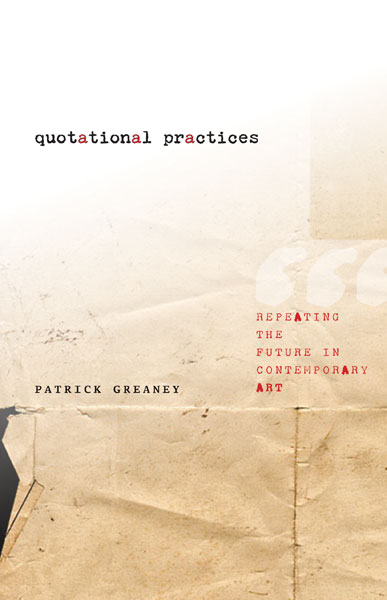Museum Highlights: The Writings of Andrea Fraser (2005)
Filed under book | Tags: · aesthetics, appropriation, art, art criticism, autonomy, capital, collecting, conceptual art, curating, institutional critique, museum, performance, performance art

“Andrea Fraser’s work, writes Pierre Bourdieu in his foreword to Museum Highlights, is able to ‘trigger a social mechanism, a sort of machine infernale whose operation causes the hidden truth of social reality to reveal itself.’ It often does this by incorporating and inhabiting the social role it sets out to critique—as in a performance piece in which she leads a tour as a museum docent and describes the men’s room in the same elevated language that she uses to describe seventeenth-century Dutch paintings. Influenced by the interdisciplinarity of postmodernism, Fraser’s interventionist art draws on four primary artistic and intellectual frameworks—institutional critique, with its site-specific examination of cultural context; performance; feminism, with its investigation of identity formation; and Bourdieu’s reflexive sociology. Fraser’s writings form an integral part of her artistic practice, and this collection of texts written between 1985 and 2003—including the performance script for the docent’s tour that gives the book its title—both documents and represents her work.
The writings in Museum Highlights are arranged to reflect different aspects of Fraser’s artistic practice. They include essays that trace the development of critical ‘artistic practice’ as cultural resistance; performance scripts that explore art institutions and the public sphere; and texts that explore the ambivalent relationship of art to the economic and political interests of its time. The final piece, ‘Isn’t This a Wonderful Place? (A Tour of a Tour of the Guggenheim Bilbao),’ reflects on the role of museums in an era of globalization. Among the book’s 30 illustrations are stills from performance pieces, some never before published.”
Edited by Alexander Alberro
Publisher MIT Press, 2005
ISBN 0262062445, 9780262062442
xxxvii+291 pages
Reviews: Kirsi Peltomaki (Afterimage, 2005), Melissa Gronlund (Frieze, 2005), Louis Byrne (Art Book, 2007), N.A. Hayes (PopMatters, 2008).
PDF (104 MB, no OCR)
Comment (0)Patrick Greaney: Quotational Practices: Repeating the Future in Contemporary Art (2014)
Filed under book | Tags: · appropriation, art criticism, authorship, conceptual writing, literary criticism

“Literature and art have always depended on imitation, and in the past few decades quotation and appropriation have become dominant aesthetic practices. But critical methods have not kept pace with this development. Patrick Greaney reopens the debate about quotation and appropriation, shifting away from claims about the death of the author. In interpretations of art and literature from the 1960s to the present, Quotational Practices shows how artists and writers use quotation not to undermine authorship and originality, but to answer questions at the heart of twentieth-century philosophies of history.
Greaney argues that quotation is a technique employed by art and philosophy to build ties to the past and to possible futures. By exploring quotation’s links to gender, identity, and history, he offers new approaches to works by some of the most influential modern and contemporary artists, writers, and philosophers, including Walter Benjamin, Guy Debord, Michel Foucault, Marcel Broodthaers, Glenn Ligon, Sharon Hayes, and Vanessa Place.
Ultimately, Quotational Practices reveals innovative perspectives on canonical philosophical texts as well as art and literature in a wide range of genres and mediums—from concrete poetry and the artist’s book to performance, painting, and video art.”
Publisher University of Minnesota Press, 2014
ISBN 9780816687343, 081668734X
xiv+217 pages
Reviews: Laura Guy (Visual Studies, 2015), Adam Barbu (Rev Cult Theory, 2016).
PDF (25 MB)
Comment (0)NSK from Kapital to Capital: Neue Slowenische Kunst: An Event of the Final Decade of Yugoslavia (2015) [English, Slovenian]
Filed under catalogue | Tags: · appropriation, art, art history, capitalism, politics, retro-avant-garde, theory, utopia, yugoslavia

“The exhibition NSK from Kapital to Capital was the first major museum project of the Neue Slowenische Kunst (NSK) collective, and followed the events of its individual constitutive groups, from 1980 and the Laibach poster scandal in Trbovlje (Slovenia) through 1992, when the art collective transformed into the NSK State in Time. The title, NSK from Kapital to Capital, places the exhibition in the socio-political context of the turbulent 1980s, when the old world order was crumbling and the all-encompassing system of global capitalism was starting to come into its own.”
Publisher Moderna Galerija, Ljubljana, 2015
ISBN 9789612061142
83 pages
via L’Internationale
From Kapital to Capital (English, 2015, 2 MB, PDF)
Od Kapitala do kapitala (Slovenian, 2015, PDF, added on 2017-11-7)

